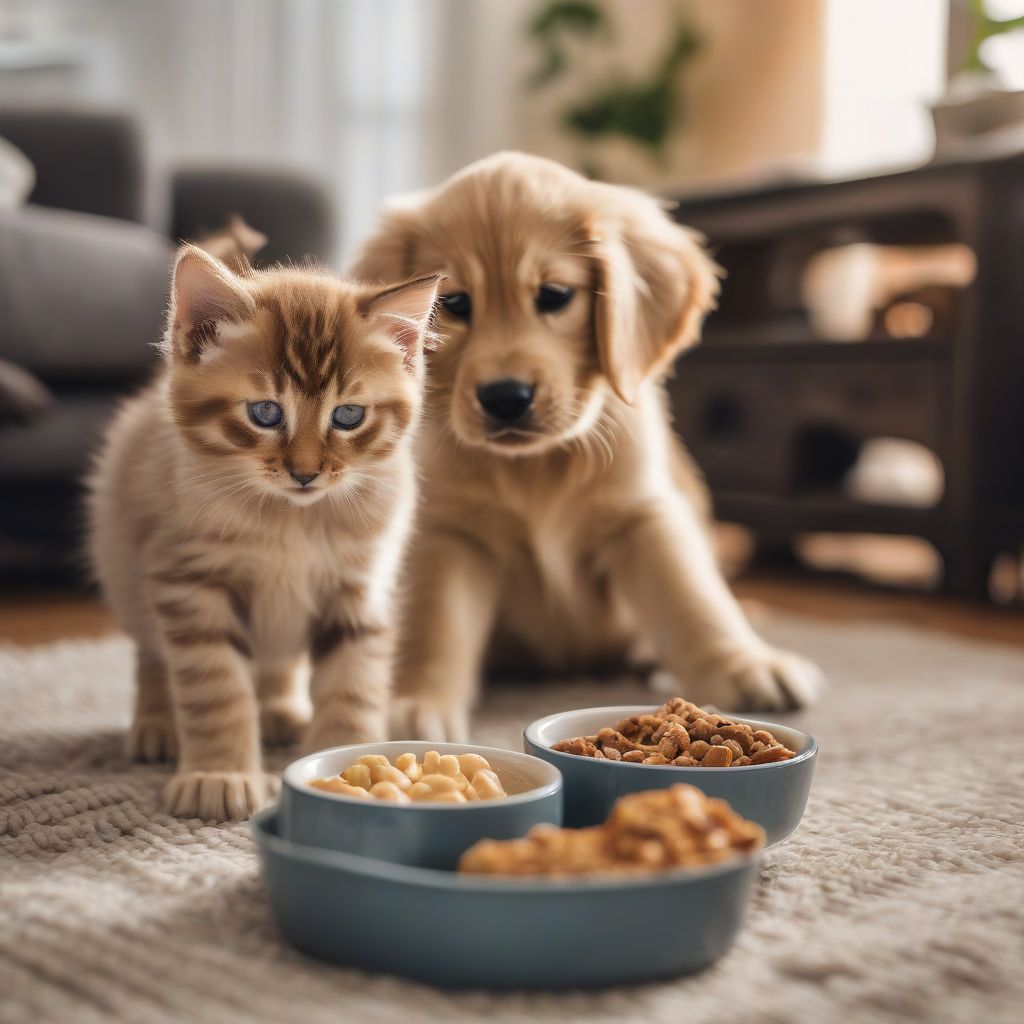Bringing a new furry friend home is an exciting time! Whether you’ve chosen a playful puppy or a cuddly kitten, providing the right nutrition is crucial for their growth and development. One of the most common questions new pet parents ask is, “What’s the best feeding schedule?” Well, just like human babies, puppies and kittens have different nutritional needs at different stages of life. This comprehensive guide will walk you through creating the perfect feeding schedule for your new companion, ensuring they get the best start in life.
Understanding Your Pet’s Nutritional Needs
Puppies and kittens grow rapidly, especially during the first few months. Their tiny bodies require a higher calorie and nutrient density than adult animals. This means feeding them more frequently and choosing food specifically formulated for their growing needs.
Puppies: From Weaning to Adulthood
- 8-12 weeks: At this stage, puppies are typically weaned from their mother’s milk and transitioning to solid food. Aim for four meals a day, spaced evenly throughout the day.
- 3-6 months: As your puppy grows, you can reduce the feeding frequency to three meals a day.
- 6-12 months: Most puppies can transition to two meals a day at this point. Larger breeds may benefit from sticking with two meals a day even into adulthood to prevent bloat.
- Adult dogs (1 year+): Most adult dogs thrive on two meals a day, but some individuals may prefer one. Consult your veterinarian for personalized advice.
Kittens: Tiny Tigers with Big Appetites
- 8-12 weeks: Like puppies, newly weaned kittens need frequent meals. Aim for four small meals a day.
- 3-6 months: Three meals a day are usually sufficient at this age.
- 6-12 months: You can gradually transition to two meals a day.
- Adult cats (1 year+): Most adult cats do well with two meals a day. Some may prefer several smaller meals or “grazing” throughout the day, especially if they have sensitive stomachs.
Choosing the Right Food
Selecting a high-quality food specifically formulated for puppies or kittens is essential. Look for food that meets the Association of American Feed Control Officials (AAFCO) standards for growth. “A good rule of thumb,” says Dr. Emily Parker, a veterinarian specializing in pet nutrition, “is to choose food with a named meat source as the first ingredient.”
Reading Food Labels: Decoding the Ingredients
Understanding food labels can be overwhelming. Focus on these key elements:
- Life stage: Ensure the label indicates the food is for “growth” or “all life stages.”
- Ingredient list: Look for whole meat sources, such as chicken, beef, or fish, as the primary ingredients. Avoid fillers like corn, wheat, and soy.
- Guaranteed analysis: This section lists the minimum percentages of protein, fat, and fiber. Puppies and kittens require higher protein and fat levels than adult animals.
Monitoring Your Pet’s Growth and Adjusting Accordingly
Every pet is different, and their growth rates can vary. Regularly monitor your puppy or kitten’s weight and body condition. If they’re gaining weight too quickly or too slowly, adjust the amount of food accordingly. “Don’t be afraid to adjust the feeding schedule based on your pet’s individual needs,” advises Dr. Parker. “Regular vet checkups are crucial to ensure your furry friend is growing at a healthy pace.”
Dealing with Picky Eaters
Some puppies and kittens can be picky eaters. If your new pet refuses to eat, try these tips:
- Warm the food slightly: This can make the food more appealing, especially for kittens.
- Mix in a small amount of wet food: Wet food is often more palatable than dry kibble.
- Offer different flavors: Experiment with different protein sources to find what your pet prefers.
- Be patient and consistent: Avoid giving in to your pet’s demands for treats or human food. This can reinforce picky eating habits.
Transitioning to Adult Food
Once your puppy or kitten reaches adulthood (around 1 year old), it’s time to transition to adult food. Do this gradually over a week or two to avoid digestive upset. Start by mixing a small amount of adult food with their current puppy or kitten food. Gradually increase the proportion of adult food while decreasing the puppy/kitten food until they are fully transitioned.
 Feeding Schedule for Puppies and Kittens
Feeding Schedule for Puppies and Kittens
The Importance of Fresh Water
Always provide fresh, clean water for your puppy or kitten. Dehydration can be dangerous, especially for young animals. Ensure their water bowl is always full and easily accessible.
Conclusion
Establishing a proper feeding schedule and choosing the right food is essential for your puppy or kitten’s health and well-being. Remember to consult with your veterinarian for personalized advice based on your pet’s breed, age, and individual needs. By following the guidelines outlined in this guide, you can ensure your furry friend gets the best possible start in life and grows into a happy and healthy companion. Do you have any tips or tricks for feeding your puppy or kitten? Share them in the comments below! And don’t forget to share this article with fellow pet parents!



